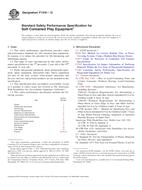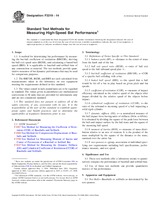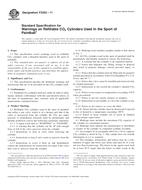We need your consent to use the individual data so that you can see information about your interests, among other things. Click "OK" to give your consent.
ASTM F2333-04(2011)
Standard Test Method for Traction Characteristics of the Athletic Shoe–Sports Surface Interface
STANDARD published on 1.11.2011
The information about the standard:
Designation standards: ASTM F2333-04(2011)
Note: WITHDRAWN
Publication date standards: 1.11.2011
SKU: NS-53588
The number of pages: 9
Approximate weight : 27 g (0.06 lbs)
Country: American technical standard
Category: Technical standards ASTM
The category - similar standards:
Annotation of standard text ASTM F2333-04(2011) :
Keywords:
athletic shoe, friction, sports surface, traction, Sports equipment (athletic footwear), Sports facilities playing surfaces, Traction characteristics, Traction/safety (for footwear), ICS Number Code 61.060 (Footwear), 97.220.01 (Sports equipment and facilities in general)
Additional information
| Significance and Use | ||
|
This test method will be used by athletic footwear manufacturers to characterize the traction of the athletic shoe-sports surface interface, and as a tool for development of athletic shoe outsoles. This test method will be used by researchers to determine the effect of sport surface conditions (for example, moisture, grass species, turf density, soil texture, soil composition, and so forth) on traction characteristics of the athletic shoe-sports surface interface. This test method will be used by sports surface manufacturers to characterize the traction of the athletic shoe-sports surface interface, and as a tool for development of sports surfaces. Careful adherence to the requirements and recommendations of this test method will provide results that compare with results from different laboratory sources. The method will be used to research relationships between traction at athletic shoe-sports surface interfaces and athletic performance or injury. This research may lead to recommendations for appropriate levels of traction. |
||
| 1. Scope | ||
|
1.1 This test method covers specifications for the performance of sports shoe-surface traction measuring devices, but does not require a specific device or mechanism to be used. Figs. 1 and 2 show schematic diagrams of generic apparatus. 1.2 This test method is appropriate for measuring the effects of athletic shoe outsole design and materials on traction at the shoe-surface interface. 1.3 This test method is appropriate for measuring the effects of sport surface design and materials on traction at the shoe-surface interface. 1.4 This test method specifies test procedures that are appropriate for both field and laboratory testing. 1.5 Traction characteristics measured by this test method encompass friction forces developed between shoe outsoles and playing surfaces. 1.6 Traction characteristics measured by this test method encompass traction achieved by penetration of cleats or studs into playing surfaces. 1.7 This test method specifies test procedures for the measurement of traction during linear translational motion and rotational motion, but not simultaneous combinations of linear and translational motion. 1.8 The loads and load rates specified in this test method are specific to sports activities. The test method is not intended for measurement of slip resistance or traction of pedestrian footwear. 1.9 Test results obtained by this method shall be qualified by the characteristics of the specimen. 1.9.1 Comparative tests of surfaces shall be qualified by the characteristics of the shoes used to test the surfaces, including the cushioning, outsole material, and sole design. 1.9.2 Comparative tests of shoes shall be qualified by the pertinent characteristics of the surfaces on which shoes are tested, including the surface type, material, condition, and temperature. 1.10 This test method does not establish performance or safety criteria. The level of traction required between a sport shoe and surface varies with the level of performance and from individual to individual. The extent to which particular levels of traction contribute to individual athletic performance and risk of injury is not known. 1.11 The values stated in SI units are to be regarded as the standard. 1.12 This standard may involve hazardous materials, operations and equipment. This standard does not purport to address all of the safety concerns, if any, associated with its use. It is the responsibility of the user of this standard to establish appropriate safety and health practices and determine the applicability of regulatory limitations prior to use. A. Shoe under test, mounted on a footform. B. Surface under test. C. Guide rails with linear bearings or other means of maintaining rectilinear motion. D, E. Vertical shaft and bearing mounted carriage or other means of maintaining motion parallel to the plane of the shoe-surface interface. F. Weights, actuator or other means of applying a downward vertical force. G. Actuator or other means of applying a horizontal force. H. Force plate or other means of measuring vertical and horizontal forces. J. Velocity transducer. FIG. 1 Schematic Diagram of a Generic Device for Measuring Linear TractionA. Shoe under test, mounted on a footform. B. Surface under test. D, E. Vertical shaft and bearings or other means of constraining rotation about the vertical axis parallel to the plane of the shoe-surface interface. F. Weights, actuator or other means of applying a downward vertical force. G. Actuator or other means of applying a torque. H. Force plate or other means of measuring vertical force and torque about the vertical axis. J. Angular velocity transducer. FIG. 2 Schematic Diagram of a Generic Device for Measuring Rotational Traction |
||
| 2. Referenced Documents | ||
|
Similar standards:
Historical
1.5.2012
Historical
1.5.2014
Historical
1.5.2011
Historical
1.12.2013
We recommend:
Technical standards updating
Do you want to make sure you use only the valid technical standards?
We can offer you a solution which will provide you a monthly overview concerning the updating of standards which you use.
Would you like to know more? Look at this page.



 ASTM F1918-12
ASTM F1918-12 ASTM F2219-14
ASTM F2219-14 ASTM F2553-11
ASTM F2553-11 ASTM F2773-13
ASTM F2773-13
 Cookies
Cookies
